Time. It’s one commodity that you can’t buy. You can’t sell it. You can’t bargain for it. You can waste it. You can pray for more of it. Once you spend it, though, you can’t get it back. So it’s good advice to invest your time wisely. That’s what this interview is all about.

Like many champions involved in a worthy pursuit, Dave Goodin, the Texas Shredder, has come to realize that the very best training method for muscle gains is persistence and consistency over time. That’s the way to get the job done. If you’re a drug-free athlete, Dave says, you’d better be willing to pay the price with quality time spent on basic workouts—injected with passion, lots of desire and friggin’ hard work.
Dave’s philosophy on training is old school. He believes in basic weight-training exercises, straight-forward workout design and simplified nutrition. Many trainees make it much more complicated than it needs to be, he maintains. Keep it simple and basic.

As they say in Texas, “If you see a turtle sittin’ on top of a fence post, chances are he had help gettin’ there.” So let’s find out how Dave can help you simplify your approach—Texas Shredder style.
DY: First, congratulations on winning the 50-and-over title at the ’09 IFBB North American Championships and earning your pro card. Man, can you stop smiling even if you try?
DG: It feels like it’s been a long time coming. I’ve always enjoyed competing, though, so getting an IFBB pro card was never a do-or-die thing for me—like it is for some. Still, it’s such an honor and such a huge accomplishment to earn the privilege of competing as an IFBB pro. I’m pretty pumped about it.
DY: It’s the stuff that says your peers validate you—a “well done.” I know it took a lot of discipline and hard work to accomplish that goal. How did you feel about your condition at the North Americans?
DG: It seemed to be harder getting into full-blown contest shape this year. Maybe it has something to do with being 50 years old. [Laughs] I wasn’t in my best condition ever at the North Americans. I was close, but I’ve definitely been in better shape. In fact, I just got back from winning my class at the Team Universe, where I was in significantly better shape than I was at the NAC three weeks ago.

DY: Congratulations on the Team Universe win as well. A lot of people have commented on your gains in size and hardness over the past few years. Do you have a new secret weapon training system?
DG: I was in tremendous shape in ’07 at the NPC South Texas and the Team Universe. I ruptured a hamstring tendon just a couple of hours after the Team U that year, but even the surgery didn’t keep me out of the gym. I had reattachment surgery on a Friday, and did an upper-body workout four days later.
Last year my upper body was improved, but my legs were still a little behind, and I didn’t get quite as shredded as I did in 2007. This year I competed at just a couple of pounds heavier, but everyone says I look bigger. It took me three shows to get into the supershredded condition that I expect from myself, but I pulled it together perfectly for the Team Universe.
DY: You dialed it right in, Dave.
DG: One of the big things that’s made a difference for the past few years is the Muscle-Link line of supplements. I’ve been particularly religious about using their GH Stak and Omega Stak. In fact, I use everything in the product line. It’s great stuff, and I recommend it to everyone.
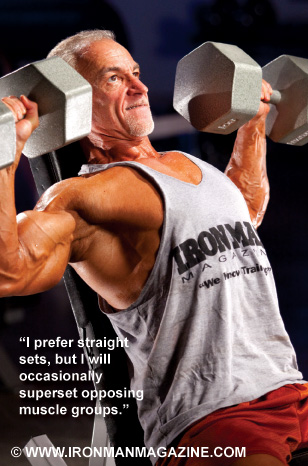
DY: How about sharing some of the wisdom you’ve gained over the years with IRON MAN readers? What training and nutrition principles do you recommend for athletes who want to maximize their muscle size and quality while training drug-free?
DG: My first recommendation for those who are committed to training drug-free is that you’re going to have to be patient. It took me 27 years to get my pro card.
My philosophy in training is to stick with the basics. If you do the basic bodybuilding exercises, train hard and train consistently, you’ll keep building muscle year after year. My diet philosophy is pretty basic too. I eat a high-protein, moderate-carb and relatively lowfat diet. I eat very clean year-round so that I don’t have to lose much weight at contest time. Rather than trying to “shock my body,” I prefer to coax it into dropping bodyfat slowly. That way I don’t lose muscle while I’m getting my bodyfat to ridiculously low levels.
Avoid fad training programs and fad diets, and be consistent about training hard and eating clean.
DY: What constitutes a basic training protocol has evolved over the years and is a topic of intense debate. About 25 years ago it was considered basic to train six days a week, hitting each bodypart twice a week. That’s evolved to training bodyparts only once a week. How do you recommend that people organize their training week?
DG: Look at the two workouts I’ve outlined. Both are designed for competitive-bodybuilder clients. One is a precontest training split [see page 125] and the other is an off-season training split [page 130].
Because I train for my guest-posing appearances as if I’m training for a contest, I’m on the four-day split at least eight to nine months per year. I vary the rep ranges and may go as heavy as three reps max on stuff like squats, bench and deadlifts at times. I’ve also been known to train for powerlifting meets, in which case I take eight to 10 weeks to cycle into a one-rep max. However, unlike most powerlifters, I include a lot of isolation exercises and some high-rep sets in my training—even at the end of the cycle.
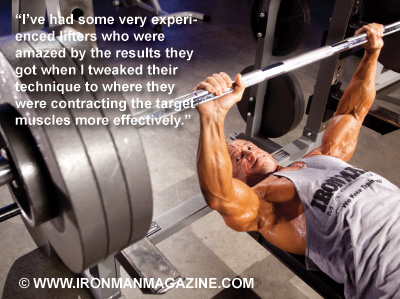
DY: So you actually favor a three-day training program for size and a four-day routine for precontest training?
DG: Yes. About 15 years ago I cut my off-season workouts from five days per week to three. I started gaining size and strength so fast that people were asking my training partner if I was using steroids. In nine months I gained more muscle than I had in the previous four years.
When I cut my precontest training from six days per week to four, I found that I was able to come in bigger and much stronger. Previously, I’d lose a lot of strength precontest. When I gave myself more rest days, I maintained more muscle and more strength, plus I didn’t have a postcontest fat rebound.
DY: Is there an ideal set-and-rep pattern that you’ve found to be more effective than others?
DG: I do most of my upper-body work in the eight-to-12-rep range. For lower body my ranges are more like eight to 20 reps.

DY: Some programs promote rep ranges that vary from week to week, while others vary rep ranges within a workout. What’s your advice on varying rep ranges?
DG: Let’s say I’m working in a heavier rep range, like six to eight reps max. I’ll do it as long as I’m making progress. If progress stalls, then I’ll switch it up. Sometimes I work mostly in low rep, medium rep or high rep for periods of time. Other times I combine rep ranges in modified pyramids.
DY: I’ve seen a lot of pros train, and I’m generally surprised by how fast they work—their cadence is pretty quick. Is there a rep speed that you’ve found works best?
DG: As I’ve gotten older, I’ve slowed my cadence. My reps are much more controlled and smooth—much more deliberate. I find it more effective and much safer than slinging around weights and letting momentum take over.
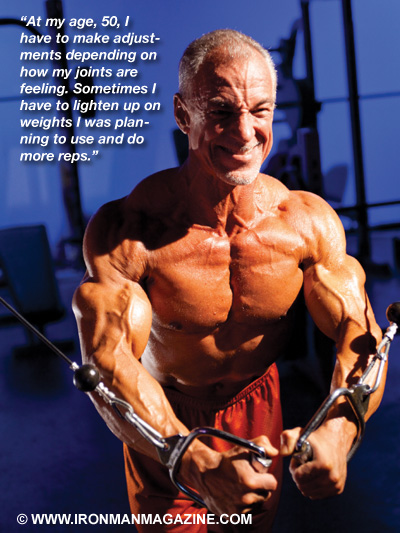
DY: Do you like straight sets, or have you found supersets, tri-sets and giant sets to have any value? I’ve found those methods to be time savers and good when I’m trying to tighten up, but they’re difficult to organize in a commercial gym.
DG: I prefer straight sets, but I occasionally superset opposing muscle groups, particularly on isolation exercises—usually when I’m pressed for time.
DY: That makes sense. When people come to you for help, assuming they’re generally healthy and are already fairly experienced in the gym, what’s the first thing you correct in their approach?
DG: I first look at exercise selection and technique. I’ve had some very experienced lifters who were amazed by the results they got when I tweaked their technique to where they were contracting the target muscles more effectively. The other thing is diet. Most of the time I have to have the person correct both.
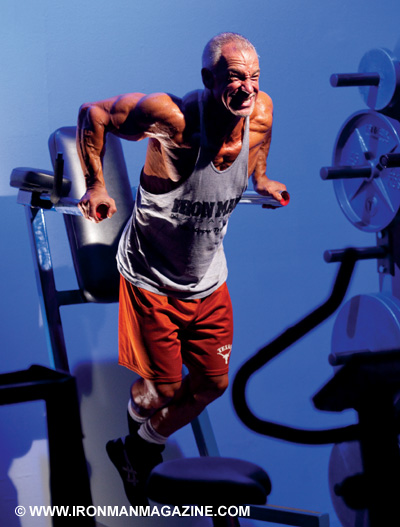
DY: What about rest periods between sets—typically how long?
DG: Rest periods depend on the exercise you’re doing and whether you’re doing max sets or warmups. Generally, I recommend longer rest periods on lower-body compound movements like squats, leg presses or deadlifts. I use 60 to 90 seconds between warmup sets, but when you get to the max sets, sometimes you might want to take three or four minutes to let the lactic acid clear and your respiration come back down. Generally with upper body you can get away with shorter rest periods because the cross-sectional area of muscle worked is much smaller. For those bodyparts it’s 45 to 60 seconds between warmups and maybe two minutes between max sets.
DY: Do you do cardio during your size phase? How much?
DG: During the off-season I do as little cardio as possible. That means none—unless there’s a really cute girl who wants me to walk with her. Still, I keep it to a minimum—not more than 30 minutes.
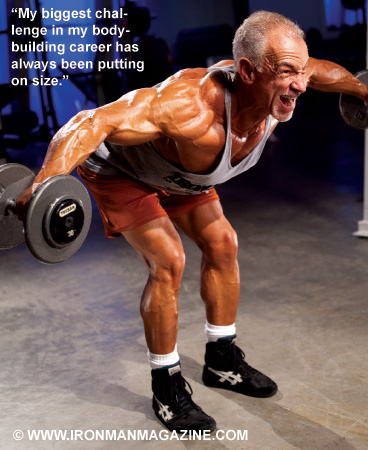
DY: Walks with a cute girl could get me to like cardio. Dave, how about a look at a day of eating and supplements for your size phase.
DG: Sure. Here you go:
Breakfast: During the work week a Starbucks Venti Black-eye and a bowl of oatmeal with 2 scoops of protein powder. On weekends I’ll have an omelet or 4 scrambled eggs and pancakes.
Midmorning: 1 package Trio-plex cookies (oatmeal or chocolate chip) and a Pro-Fusion protein drink
During workout: 16 ounces Gatorade plus 1/2 scoop Pro-Fusion
Immediately postworkout: 20 ounces Gatorade plus 2 scoops Pro-Fusion and 1 scoop CreaSol
Lunch: 10-12 ounces grilled chicken, green salad with lowfat dressing, 1-2 pieces fruit
Midafternoon: 20 ounces Gatorade plus 2 scoops Pro-Fusion or 1 packet Muscle Meals
Dinner: 12-16 ounces grilled chicken, fish or superlean ground beef; rice or pasta; spinach salad
If my meals get spread out too far because of my work schedule, I snack on Trio-plex cookies or Labrada Lean Body bars.
Here’s the supplements list:
GH Stak: first thing in the morning
Omega Stak: 3 gel caps with breakfast, lunch and dinner
Mona Vie antioxidants drink: with breakfast
CreaSol: postworkout
Pro-Fusion whey, casein and egg protein: various times
Muscle Meals meal-replacement packets: various times
Red Dragon (beta-alanine) and Cort-Bloc (phosphatidylserine): 30 minutes before workout
Ribose Size: postworkout
Pharmanex Lifepak Nano vitamins: with dinner
ZMAT: at bedtime
Muscle-Link is coming out with a workout energy shot soon. I got to try the prototype when I was in Los Angeles for my last photo shoot, and I loved it. I can’t wait until it’s out for distribution.
DY: What about the mind-set factor? I know contest training and dieting bring their own mental challenges, but how do you handle the challenges that come during the size phase?
DG: My mental approach during the off-season is that I want to hit every workout as hard as possible. Unfortunately, at my age I have to make adjustments depending on how my joints are feeling. Sometimes I have to lighten up on the weights I was planning to use and do more reps. Sometimes I just have to back off the intensity and get a fairly solid workout without irritating old injuries. I enjoy training hard, and when I have to back off, it’s not very much fun.
DY: I know all about making adjustments for age. Do you have a training partner?
DG: I train with a partner most of the time. Most of my training partners for about the past seven or eight years have been women. I find that it’s better for me to train with women now because when I work out with the guys, I sometimes get too competitive and end up using weights that are heavier than I should use, which leads to injuries. Believe me, the girls don’t cut me any slack. If my form is less than perfect, or if they don’t think I’m training hard enough, they’ll talk some serious smack. I love to lift, but training with hot women makes it even more fun.
DY: I’ve had women training partners, and I’ve also noticed that women tend to be stricter on form. I think it’s because their egos aren’t as wrapped up in how much weight is on the bar—plus, their threshold for pain is higher. So the competition does come in, but it’s more about can you withstand the pain.
DG: I’d have to agree.
DY: How would you say your training style has changed from what you might have done 10 or even 15 years ago?
DG: That’s an easy one. I can’t train with the reckless abandon that I used even 10 years ago. I have to focus much more on perfect form and moving the weight very smoothly and deliberately. I think I’m much more aware of contracting the muscles than I was 10 or 15 years ago. On some of the exercises I use a little less weight, which I don’t really like—but I have to stay healthy. The biggest thing about getting older is that you don’t heal up nearly as fast as you did when you were younger. If you get overzealous and get inflammation in a joint, it sometimes lingers for months.
DY: Heck, it can linger for years if you’re not careful. Which bodyparts respond easily for you, and which have been more challenging?
DG: Abs. Believe it or not, I train my abs just once a week precontest and usually not at all in the off-season. If your abs respond well and you train them too much, you’ll end up adding inches to your waist. I had that happen and backed off my ab training to reduce my waist size.
Everything else has been challenging for me. Over the past decade or so legs have been the most challenging. I tore some soft tissue in my knee doing a successful 600-pound squat. I ended up having to have my knee scoped to clean out the scar tissue. It didn’t completely correct the problem, and my knee hurt for years on squats. About the time that one stopped hurting, the other knee got tendinitis because I’d been putting more weight on it for so long. Both knees were doing pretty well for a short time, and then I ruptured a hamstring tendon. Ever since I got off the crutches from that surgery two years ago, I’ve had a problem with the hip flexor on the other leg, which causes me a great deal of back pain. Being the bodybuilder that I am, however, I just work through it because that’s what we do.
DY: Let’s switch gears a bit. Which bodybuilders of the past and present exemplify the type of physique you consider to be ideal?
DG: I would have to go with Frank Zane, Lee Labrada, Mohamed Makkawy. You just don’t see physiques that look like that anymore among the top pros. It’s all about supersize now.
DY: What have been the biggest challenges in your bodybuilding career?
DG: My biggest challenge in my bodybuilding career has always been putting on size. I’m a naturally thin person, and if I don’t weight-train, I lose weight really fast. In the past 28 years the longest I’ve ever been off of weight training was six weeks—one time. I lost 15 pounds in six weeks. The next longest was two weeks. I lose six to eight pounds if I don’t train for two weeks.
The other big challenge has been dealing with injuries. I had the knee injury, a ruptured biceps tendon, a ruptured hamstrings tendon, a torn posterior labrum in both shoulders and then just frequent tendinitis in various joints. I always wished that I could train for a year with no joint pain, but that hasn’t happened since I was in my mid-20s.
DY: How about the biggest challenges outside the gym?
DG: My biggest challenges in my personal life have been my relationships with women and my finances. Since my first marriage, I can’t seem to stay in a relationship for more than two or three years. I’m not sure why, so I like to blame being a military brat. We never lived anywhere for more than three years, so I was always picking up and leaving all of my friends in about that time frame. I’m a really nice, easy-going guy, so that seems as plausible an explanation as I can come up with.
My other big challenge—and right now my biggest challenge—is finances. As a teacher and coach I never made much money. I did that for nine years and then gave it up to go into personal training. Once I got my training business established, I was making almost twice as much money. Three years into personal training I sunk my life savings into Hyde Park Gym.
The gym was struggling, but I got it turned around pretty quickly and was making great money for about six or seven years. Then a 24 Hour Fitness opened up just a mile away. With all the shiny new equipment and cheap memberships, it took just enough of my business to take away my profit margin. For about a year I was struggling to break even. When I decided to sell it, members found out and many bailed on me. It took months to get the deal closed, and I lost a great deal of money. I still haven’t recovered from that, but you just gotta keep on keeping on, right? When I read the interview that L.T. did with Doug Brignole in the October ’09 IRON MAN, his story hit very, very close to home.
DY: Well, I’ll drink a protein shake with you to toast your finances’ turning around with your new pro status. Thanks for a great interview.
DG: Thank you.
Editor’s note: To contact Dave for guest-posing appearances or for help with contest preparation, visit his Web site, www.DaveGoodin.com. You can read his blog at www.IronManMagazine.com. To learn more about Muscle-Link products, go to www.Muscle-Link.com. IM
Dave’s Four-Day Precontest Split
Monday: Legs
Squats (warmup) 1-3 x 10, 2 x 10RM, 1 x 20RM
Squats are done with a free bar, going deep—top of the thighs breaking parallel to the ground.
Leg presses (warmup) 2-3 x 20, 3 x 20RM
Leg curls 4 x 12RM
Leg extensions 4 x 12RM
Standing calf raises (warmup) 2 x 15, 4 x 15RMTuesday: Chest
Bench presses (warmup) 2-3 x 10,3-4 x 10RM
Incline presses (warmup) 1 x 10, 3-4 x 10RM
Cable crossovers or machine flyes 4 x 15RM
Dumbbell pullovers (warmup) 1 x 12, 3 x 12RMWednesday: Cardio and Abs
Hanging leg raises 4 x max
Crunches 4 x maxThursday: Back
Deadlifts (warmup) 1-3 x 8, 2 x 6RM
Partial deadlifts 3 x 15RM
Partial reps are from the knees up, with legs slightly bent.
Pulldowns (warmup) 1 x 10, 3 x 10RM
Seated cable rows 4 x 10RM
High-pulley rows or Hammer Strength high rows 4 x 10RM
Straight-arm pulldowns 4 x 12RMFriday: Shoulders and Arms
Seated dumbbell presses (warmup) 1-2 x 10, 4 x 10RM
Lateral raises 4 x 12 RM
Machine rear-delt flyes or bent-over laterals 4 x 12RM
Seated dumbbell curls (warmup) 1 x 10, 4 x 10RM
Cable or EZ-curl-bar curls 4 x 15RM
Dips (warmup) 1 x 10, 4 x max
Pushdowns or skull crushers (warmup) 1 x 10, 4 x 10RM
Note: RM stands for repetitions maximum, so I start with a weight that I can do for about the designated number of reps and do as many as I can on each set.
— Dave Goodin
The Texas Shredder Power-Bodybuilding Program
Here’s my modified powerlifting program. It includes more assistance work than traditional meet-preparation programs, but it’s for bodybuilders who want to use powerlifting for fun and as a means of enhancing their physiques. The modified program also makes it easier to transition back into your regular bodybuilding routine after you’re done with your meet. It’s the routine I used in 1997, when I had my best meet ever, set all my personal bests and won a national championship.
Squat Day
Squats: warmup sets as needed, 3 work sets with the prescribed weight, 1 set with 12RM weight
Leg presses or hack squats 3 x 12
Leg curls 3 x 12
Standing calf raises 4 x 12-15
Crunches 3 x maxBench Day
Bench presses: warmup sets as needed, 3 work sets with the prescribed weight, 1 set with 12RM weight
Incline presses 3 x 12
Overhead dumbbell presses or barbell presses 3 x 10-12
Lateral raises 3 x 10-12
EZ-curl-bar curls 3 x 10-12
Hammer curls 3 x 10-12Deadlift Day
Deadlifts: warmup sets as needed, 3 work sets with the prescribed weight
Partial deadlifts (in the power rack from the knees up) 3 x 10-12
Pullups (bodyweight) 3 x max
Cable rows or one-arm dumbbell rows 3 x 10-12
Machine rear-delt flyes 3 x 10-12
Dips (bodyweight) 3 x max
Skull crushers 3 x 10-12
Hanging leg raises 3 x maxHere’s how I figure my weekly weights for the powerlifts: I start week 1 with my 10-rep max—that’s 10 reps per minute. For my squats it’s 315 pounds. I know that my realistic goal for the meet is 500 pounds. I divide the difference—185—by 9, which equals 20.5. I start week 1 using 315 pounds and add 20 pounds per week, which puts my work sets at 495 by week 10. On meet day I may attempt more than 500 if everything is feeling good. This year my squat and deadlift starting weights and goal weights will be approximately the same—315 and 500, respectively. My bench starting weight will be 225, and my goal is 320. At right is my weekly weight schedule
Weight Schedule
Squat/Deadlift Bench Press
Week 1 315 225
Week 2 335 235
Week 3 355 245
Week 4 375 255
Week 5 395 265
Week 6 415 275
Week 7 435 285
Week 8 455 295
Week 9 475 305
Week 10 495 315
Meet day 500 320—D.G.
Goodin ‘Nuf Three-Day Size Split
Monday: Legs, Abs
Squats (warmup) 2-3 x 10, 3 x 8RM, 1 x 20RM
Leg presses (warmup) 2-3 x 10, 3 x 10RM, 1 x 20RM
Leg curls (warmup) 1 x 10, 4 x 10RM
Standing calf raises (warmup) 2 x 15, 4 x 15RM
Hanging leg raises/knee raises 3 x max
Crunches 3 x maxWednesday: Chest, Shoulders, Biceps
Bench presses (warmup) 3 x 10, 4 x 8RM
Incline presses (warmup) 1-2 x 10, 3 x 8RM
Pec deck flyes 3 x 15RM
Seated dumbbell presses
(warmup) 1-2 x 10, 3 x 8RM
Lateral raises (warmup) 1 x 10, 3 x 10RM
Barbell curls (warmup) 1-2 x 10, 4 x 8RM
Cable curls 3 x 15RMFriday: Back, Rear Delts, Triceps
Partial deadlifts (from the knees up, legs just slightly bent) (warmup) 1-2 x 10, 3 x 15RM
Pulldowns (warmup) 1 x 10, 4 x 8RM
Seated cable rows (warmup) 1-2 x 10, 3 x 8RM
High-pulley rows 3 x 10RM, Machine rear-delt flyes or bent-over laterals (warmup) 1 x 10, 4 x 10RM
Dips (warmup) 1 x 10, 4 x max
Pushdowns or skull crushers (warmup) 1 x 8, 4 x 8RMNote: RM stands for repetitions maximum, so I start with a weight that I can do for about the designated number of reps and do as many as I can on each set.
—D. G.














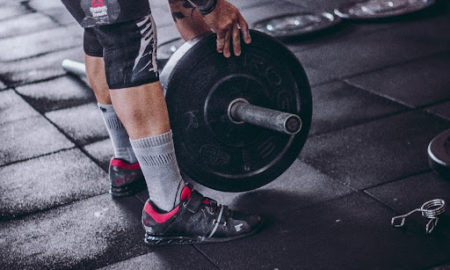
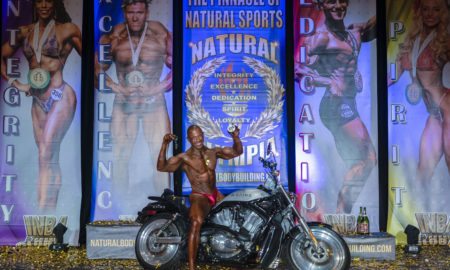
You must be logged in to post a comment Login